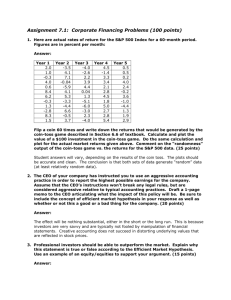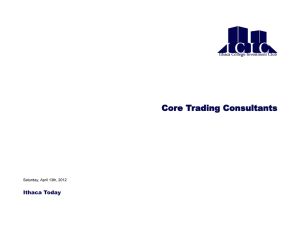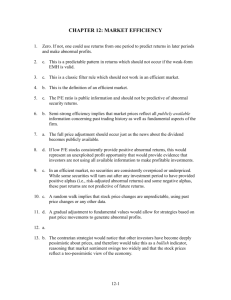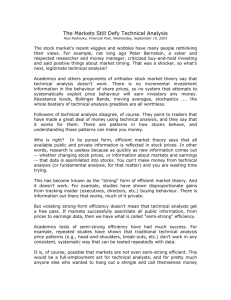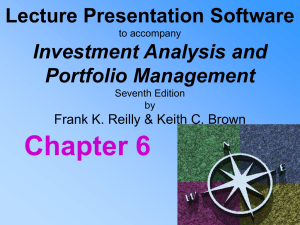to view the attachment
advertisement
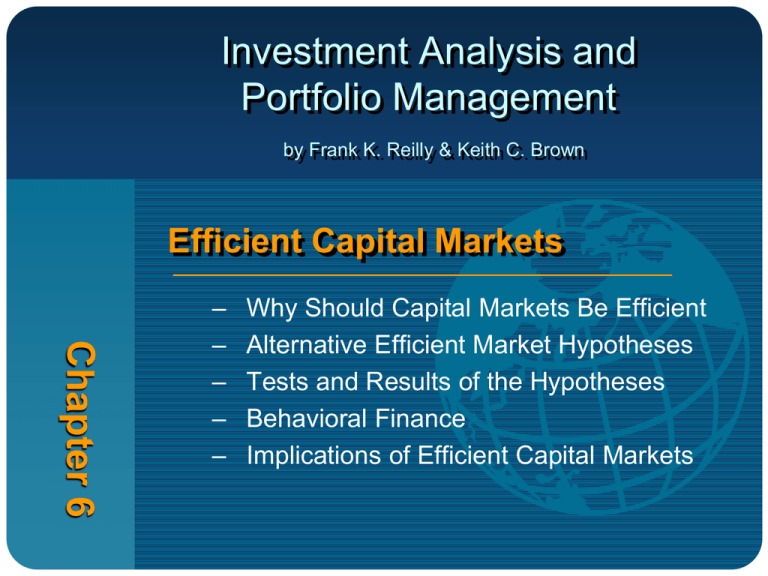
Investment Analysis and Portfolio Management by Frank K. Reilly & Keith C. Brown Efficient Capital Markets Chapter 6 – – – – – Why Should Capital Markets Be Efficient Alternative Efficient Market Hypotheses Tests and Results of the Hypotheses Behavioral Finance Implications of Efficient Capital Markets Why Should the Markets Be Efficient? • Premises of An Efficient Market – A large number of competing profit-maximizing participants analyze and value securities, each independently of the others – New information regarding securities comes to the market in a random fashion – Profit-maximizing investors adjust security prices rapidly to reflect the effect of new information 6-2 Why Should the Markets Be Efficient? • The Results – Security price changes should be independent and random – The security prices that prevail at any time should be an unbiased reflection of all currently available information – In an efficient market, the expected returns implicit in the current price of a stock should be consistent with the perceived risk of the stock 6-3 Efficient Market Hypotheses (EMH) • Random Walk Hypothesis – Changes in security prices occur randomly • Fair Game Model – Current market price reflect all available information about a security and the expected return based upon this price is consistent with its risk • Efficient Market Hypothesis (EMH) – Divided into three sub-hypotheses depending on the information set involved 6-4 Efficient Market Hypotheses (EMH) • Weak-Form EMH – Current prices reflect all security-market historical information, including the historical sequence of prices, rates of return, trading volume data, and other market-generated information – This implies that past rates of return and other market data should have no relationship with future rates of return – In short, prices reflect all historical information 6-5 Efficient Market Hypotheses (EMH) • Semistrong-Form EMH – Current security prices reflect all public information, including market and non-market information – This implies that decisions made on new information after it is public should not lead to above-average risk-adjusted profits from those transactions – In short, prices reflect all public information 6-6 Efficient Market Hypotheses (EMH) • Strong-Form EMH – Stock prices fully reflect all information from public and private sources – This implies that no group of investors should be able to consistently derive above-average riskadjusted rates of return – This assumes perfect markets in which all information is cost-free and available to everyone at the same time – In short, prices reflect all public and private information 6-7 Tests and Weak-Form EMH • Statistical Tests of Independence – Autocorrelation tests – Runs tests • Tests of Trading Rules – Testing constraints • Use only publicly available data • Include all transactions costs • Adjust the results for risk – Only better-known technical trading rules have been examined • Too much subjective interpretation of data • Almost infinite number of trading rules 6-8 Tests of Weak-Form EMH • Simulations of Specific Trading Rules – Trades a stock when the price change exceeds a filter value – Studies of this trading rule have used a range of filters from 0.5 percent to 50 percent – When these trading costs were considered, all the trading profits turned to – losses • Testing results generally support the weakform EMH, but results are not unanimous 6-9 Tests of Semistrong Form EMH • Two Sets of Studies – Time series analysis of returns or the cross-section distribution of returns for individual stocks. If the market is efficient, individual stock returns shouldn’t be predicted with past returns or other public information. – Event studies that examine how fast stock prices adjust to specific significant economic events. If the market is efficient, it would not be possible for investors to experience superior risk-adjusted returns by investing after the public announcement and paying normal transaction costs 6-10 Tests of Semistrong Form EMH • Adjustment for Market Effects – Test results should adjust a security’s rate of return for the rate of return of the overall market during the period considered – Abnormal rate of return ARit = Rit - Rmt where: ARit = abnormal rate of return on security i during period t Rit = rate of return on security i during period t Rmt =rate of return on a market index during period t 6-11 Tests of Semistrong Form EMH • Return Prediction Studies – Predict the time series of future rates of return for individual stocks or the aggregate market using public information • Predict Cross-Sectional Returns – Look for public information regarding individual stocks that will help predict the cross-sectional distribution of future risk-adjusted rates of return – These tests involve a joint hypothesis and are dependent both on market efficiency and the asset pricing model used 6-12 Return Prediction Studies • Time Series Tests for Abnormal Return – Short-horizon returns have limited results – Long-horizon returns analysis has been quite successful based on • dividend yield (D/P) • default spread • term structure spread – Quarterly earnings reports may yield abnormal returns due to • unanticipated earnings change 6-13 Return Prediction Studies • Quarterly Earnings Reports – Large Standardized Unexpected Earnings (SUEs) result in abnormal stock price changes, with over 50% of the change happening after the announcement – Unexpected earnings can explain up to 80% of stock drift over a time period – These results suggest that the earnings surprise is not instantaneously reflected in security prices 6-14 Return Prediction Studies • The January Anomaly – Stocks with negative returns during the prior year had higher returns right after the first of the year – Tax selling toward the end of the year has been mentioned as the reason for this phenomenon – Such a seasonal pattern is inconsistent with the EMH – Several studies in foreign markets found abnormal returns in January, but the results could not be explained by tax laws. 6-15 Return Prediction Studies • Other Calendar Effects – All the market’s cumulative advance occurs during the first half of trading months – Monday/weekend returns were significantly negative – For large firms, the negative Monday effect occurred before the market opened (it was a weekend effect), whereas for smaller firms, most of the negative Monday effect occurred during the day on Monday (it was a Monday trading effect) 6-16 Predicting Cross-Sectional Returns • Price-Earnings Ratios – Low P/E stocks experienced superior risk-adjusted results relative to the market, whereas high P/E stocks had significantly inferior risk-adjusted results – Publicly available P/E ratios possess valuable information regarding future returns – This is inconsistent with semistrong efficiency 6-17 Predicting Cross-Sectional Returns • Price-Earnings/Growth Rate (PEG) Ratios – Studies have hypothesized an inverse relationship between the PEG ratio and subsequent rates of return. This is inconsistent with the EMH – The results are mixed • Several studies using either monthly or quarterly rebalancing indicate an anomaly • In contrast, a study with more realistic annual rebalancing indicated that no consistent relationship exists between the PEG ratio and subsequent rates of return. 6-18 Predicting Cross-Sectional Returns • The Size Effect – Several studies have examined the impact of size on the risk-adjusted rates of return – The studies indicate that risk-adjusted returns for extended periods indicate that the small firms consistently experienced significantly larger riskadjusted returns than large firms – Firm size is a major efficient market anomaly – The small-firm effect is not stable from year to year 6-19 Predicting Cross-Sectional Returns • Neglected Firms and Trading Activity – Firms divided by number of analysts following a stock – Small-firm effect was confirmed – Neglected firm effect caused by lack of information and limited institutional interest – Neglected firm concept applied across size classes – Size effect was confirmed, but no significant difference was found between the mean returns of the highest and lowest trading activity portfolios 6-20 Predicting Cross-Sectional Returns • Book Value to Market Value Ratio – Significant positive relationship found between current values for this ratio and future stock returns – Results inconsistent with the EMH – Size and BV/MV dominate other ratios such as E/P ratio or leverage – This combination only works during expansive monetary policy – See Exhibit 6.1 6-21 Exhibit 6.1 6-22 Predicting Cross-Sectional Returns • Summary – Firm size has emerged as a major predictor of future returns – This is an anomaly in the efficient markets literature – Attempts to explain the size anomaly in terms of superior risk measurements, transactions costs, analysts attention, trading activity, and differential information have not succeeded 6-23 Event Studies • Stock split studies show that splits do not result in abnormal gains after the split announcement, but before • Initial public offerings seems to be underpriced by almost 18%, but that varies over time, and the price is adjusted within one day after the offering • Listing of a stock on an national exchange such as the NYSE may offer some short term profit opportunities for investors 6-24 Event Studies • Stock prices quickly adjust to unexpected world events and economic news and hence do not provide opportunities for abnormal profits • Announcements of accounting changes are quickly adjusted for and do not seem to provide opportunities • Stock prices rapidly adjust to corporate events such as mergers and offerings 6-25 Event Studies • Strong support from numerous event studies with the exception of exchange listing studies • In contrast – Studies on predicting rates of return for a crosssection of stocks indicates markets are not semistrong efficient • Dividend yields, risk premiums, calendar patterns, and earnings surprises – This also included cross-sectional predictors such as size, the BV/MV ratio (when there is expansive monetary policy), E/P ratios, and neglected firms. 6-26 Tests of Strong-Form EMH • Strong-form EMH contends that stock prices fully reflect both public and private • This implies that no group of investors with private information will consistently earn above-average profits • Testing Groups of Investors – – – – 6-27 Corporate insiders Stock exchange specialists Security analysts Professional money managers Corporate Insider Trading • Corporate insiders include major corporate officers, directors, and owners of 10% or more of any equity class of securities • Insiders must report to the SEC each month on their transactions in the stock of the firm for which they are insiders • These insider trades are made public about six weeks later and allowed to be studied • Corporate insiders generally experience above-average profits especially on purchase transactions 6-28 Corporate Insider Trading • This implies that many insiders had private information from which they derived aboveaverage returns on their company stock • Public Investors – After transaction costs, following insider trading will not be generally profitable for public investors according to the latest studies – However, one can increase returns from using insider trading information by combining it with key financial ratios and the type of insiders 6-29 Stock Exchange Specialists • Specialists have monopolistic access to information about unfilled limit orders • You would expect specialists to derive aboveaverage returns from this information • The data generally supports this expectation 6-30 Security Analysts • Tests have considered whether it is possible to identify a set of analysts who have the ability to select undervalued stocks • The analysis involves determining whether, after a stock selection by an analyst is made known, a significant abnormal return is available to those who follow their recommendations 6-31 Security Analysts • The Value Line Enigma – Value Line (VL) publishes financial information on about 1,700 stocks – The report includes a timing rank from 1 down to 5 – Firms ranked 1 substantially outperform the market – Firms ranked 5 substantially underperform the market – Changes in rankings result in a fast price adjustment – Some contend that the Value Line effect is merely the unexpected earnings anomaly due to changes in rankings from unexpected earnings 6-32 Security Analysts • Analysts Recommendations – There is evidence in favor of existence of superior analysts who apparently possess private information – Analysts appear to have both market timing and stock-picking ability – Consensus recommendations do not contain incremental information, but changes in consensus recommendations are useful. – The most useful information consisted of upward earning revision 6-33 Professional Money Managers • Money Managers – Trained professionals, working full time at investment management – If any investor can achieve above-average returns, it should be this group – If any non-insider can obtain inside information, it would be this group due to the extensive management interviews that they conduct 6-34 Professional Money Managers • The Performance – Most tests examine mutual funds – New tests also examine trust departments, insurance companies, and investment advisors – Risk-adjusted, after expenses, returns of mutual funds generally show that most funds did not match aggregate market performance – See Exhibit 6.3 6-35 Exhibit 6.3 6-36 Behavioral Finance • It is concerned with the analysis of various psychological traits of individuals and how these traits affect the manner in which they act as investors, analysts, and portfolio managers • There is no unified theory of behavioral finance and the emphasis has been on identifying portfolio anomalies that can be explained by various psychological traits 6-37 Behavioral Finance • Explaining Biases – Prospect Theory • Contends that utility depends on deviations from moving reference point rather than absolute wealth – Overconfidence (confirmation bias) • Look for information that supports their prior opinions and decision – Noise Traders • Influenced strongly by sentiment, they tend to move together, which increases the prices and the volatility – Escalation Bias • Put more money into a bad investment 6-38 Behavioral Finance • Fusion Investing – The integration of two elements of investment valuation-fundamental value and investor sentiment – During some periods, investor sentiment is rather muted and noise traders are inactive, so that fundamental valuation dominates market returns – In other periods, when investor sentiment is strong, noise traders are very active and market returns are more heavily impacted by investor sentiments 6-39 Implications of Efficient Capital Markets • Overall, the results of many studies indicate the capital markets are efficient as related to numerous sets of information • On the other hand, there are substantial instances where the market fails to rapidly adjust to public information • What are the implications for investors in light of these mixed evidence? – Technical Analysis – Fundamental Analysis – Portfolio Management 6-40 Technical Analysis • Assumptions of technical analysis directly oppose the notion of efficient markets • Technicians believe that new information is not immediately available to everyone, but disseminated from the informed professional first to the aggressive investing public and then to the masses • Technicians also believe that investors do not analyze information and act immediately 6-41 Technical Analysis • Stock prices move to a new equilibrium after the release of new information in a gradual manner, causing trends in stock price movements that persist for periods of time • Technical analysts develop systems to detect movement to a new equilibrium (breakout) and trade based on that • If the capital market is weak-form efficient, a trading system that depends on past trading data has no value 6-42 Fundamental Analysis • Fundamental analysts believe that there is a basic intrinsic value for the aggregate stock market, various industries, or individual securities and these values depend on underlying economic factors • Investors should determine the intrinsic value of an investment at a point in time and compare it to the market price 6-43 Fundamental Analysis • If you can do a superior job of estimating intrinsic value, you can make superior market timing decisions and generate above-average returns • Intrinsic value analysis involves: – Aggregate market analysis – Industry and company analysis 6-44 Aggregate Market Analysis • EMH implies that examining only past economic events is not likely to lead to outperforming a buy-and-hold policy because the market adjusts rapidly to known economic events • Merely using historical data to estimate future values is not sufficient • You must estimate the relevant variables that cause long-run movements 6-45 Industry and Company Analysis • Wide distribution of returns from different industries and companies justifies industry and company analysis • Must understand the variables that effect rates of return and • Do a superior job of estimating future values of these relevant valuation variables, not just look at past data 6-46 Industry and Company Analysis • Important relationship between expected earnings and actual earnings • Accurately predicting earnings surprises • Strong-form EMH indicates likely existence of superior analysts • Studies indicate that fundamental analysis based on E/P ratios, size, and the BV/MV ratios can lead to differentiating future return patterns 6-47 Fundamental Analysis Conclusion • Estimating the relevant variables is as much an art and a product of hard work as it is a science • Successful investor must understand what variables are relevant to the valuation processes and have the ability and work ethic to do a superior job of estimating these important valuation variables 6-48 Efficient Markets & Portfolio Management • Portfolio Managers with Superior Analysts – Concentrate efforts in mid-cap stocks that do not receive the attention given by institutional portfolio managers to the top-tier stocks – The market for these neglected stocks may be less efficient than the market for large well-known stocks 6-49 Efficient Markets & Portfolio Management • Portfolio Managers without Superior Analysts – Determine and quantify your client's risk preferences – Construct the appropriate portfolio – Diversify completely on a global basis to eliminate all unsystematic risk – Maintain the desired risk level by rebalancing the portfolio whenever necessary – Minimize total transaction costs 6-50 Efficient Markets & Portfolio Management • The Rationale and Use of Index Funds and Exchange-Traded Funds – Efficient capital markets and a lack of superior analysts imply that many portfolios should be managed passively (so their performance matches the aggregate market, minimizes the costs of research and trading) – Institutions created market (index) funds which duplicate the composition and performance of a selected index series 6-51 Efficient Markets & Portfolio Management • Insights from Behavioral Finance – Growth companies will usually not be growth stocks due to the overconfidence of analysts regarding future growth rates and valuations – Notion of “herd mentality” of analysts in stock recommendations or quarterly earnings estimates is confirmed 6-52 The Internet Investments Online • http://www.bloomberg.com • http://news.ft.com • http://www.online.wsj.com • http://finance.yahoo.com • http://money.cnn.com • http://www.cnbc.com • http://www.abcnews.com • http://www.nbcnews.com • http://www.msnbc.msn.com 6-53



